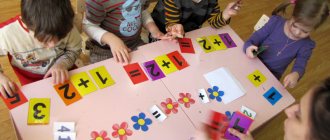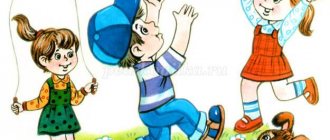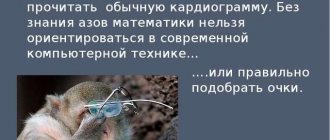Didactic games on FEMP in the middle group
We present games for the formation of elementary mathematical concepts in preschoolers 4–5 years old. Children learn to count, operate with spatial and temporal representations, analyze, compose, compare, organize objects, and use appropriate lexical concepts. Preschoolers develop color perception and an understanding of sequence. Games develop memory, speech skills, concentration, and the ability to think logically.
Geometry
Children receive 10–20 counting sticks and 2 laces 20–30 cm long. These devices are used to create various flat figures. The sticks are used to make shapes with angles: squares, rectangles, triangles of different sizes. And the laces are made into ovals and circles.
Beads for matryoshka
The teacher prepares a cord and attaches small images of geometric figures in a certain order to it from the right edge. Next he asks the children to continue making beautiful beads for the nesting doll. Players take geometric figures from the box and stick them on a string in the correct order.
Harvest
To play, you need two different-sized baskets and images of vegetables and fruits of different sizes. The game task is to sort the harvest into baskets: put large fruits in the larger one, and small ones in the smaller one. During the game, children tell what size baskets they see in front of them, what vegetables and fruits they put in them.
Tails
To play you need toy animals: elephant, bunny, monkey, fox, bear cub. Animals cannot figure out whose tail is longer. Children must resolve the dispute. They measure the tails by placing them next to each other and compare them using the appropriate adjectives: long, short, big, small.
Right wrong
The teacher distributes two circles to the students: red and green. Then he pronounces phrases on the theme of the seasons of the year and time of day. Children raise a red circle if the phrase is incorrect, for example, “after autumn came spring.” Or a green circle if the phrase is correct, for example, “the boy does exercises in the morning.”
Find the item
The teacher hides an object in the playroom, and the child must find it, following the clues. The teacher says, for example: “Three steps to the right, one forward, bend over, look under the table.” The child tries to do everything he hears.
Circle and oval
The teacher attaches several ovals and circles of different sizes and colors to the magnetic board. He asks how the figures differ and how they are similar. The children answer that they have no corners. The teacher invites the students to roll the figures on a horizontal surface. Children note that circles roll easily, but ovals do not. They reason about why this is so and superimpose the figures on top of each other. And they come to the conclusion that the ovals are elongated, so they cannot roll.
Tell me the time of day
For the game you need plot pictures of what children do during the day: exercise, breakfast, brushing teeth, walking, etc. The teacher shows the picture, the player names the time of day when the depicted action occurs. For a correct answer he gets a chip. The player with the most chips wins.
For some actions there may be two correct answers. For example, you should brush your teeth in the morning and evening.
Find a place
Children stand in a row. The teacher gives each player a task where to stand. For example: “Misha, stand to the right of Olya”, “Vova, stand behind Kostya”, “Yulia, stand in front of Vitya”. Having distributed themselves in the indicated places, the children say in detail who is in front of them, behind them, to the right and to the left.
Didactic games on FEMP in the senior group
For older preschoolers, learning to count, add, and subtract is important. Games teach children 5–6 years old to answer questions using numerals.
Name the adjacent numbers
The players stand in a circle, the teacher stands in its center. He throws the ball to the children one by one and names the number. And the players must name the numbers adjacent to the right and left in the row.
Square mosaic
The player receives 36 diagonally cut squares of 8x8 cm. The shapes must differ in color. Each piece of squares must be numbered on the back.
Players complete the following tasks:
- arrange parts of squares by color;
- sorted by numbers;
- put the pieces together into squares;
- combine the parts to form new squares.
Count the balls
The teacher puts balls into large mesh bags: one contains 6 large ones, the other contains 7 small ones. Children guess which bag has more balls. The teacher asks how to prove this statement. At the teacher’s prompting, the children arrange the balls in pairs: small and large. One small ball ends up without a pair. This means there are more small ones. Then the teacher asks how to equalize the balls. You need to either remove one small one or add a large one.
Sound score
Children receive cards with numbers up to 10. The teacher hides behind a fence and knocks on a tambourine or drum a certain number of times. Players listen carefully to the number of strokes, then raise the corresponding number.
The game can be made more difficult. The teacher asks to raise the number, more or less than the number of beats.
Name the day of the week
The players form a circle, the teacher stands in its center. He throws the ball to the children one by one and asks questions about the days of the week. For example: “What day is it before Friday?” or “What day is tomorrow?”
Matryoshka dolls
Players of 6–10 people stand in a row, tie scarves of different colors, and say out loud their serial number. The driver listens carefully, then leaves the room. Two players change places. The driver, returning to the room, speaks using numerals, what has changed. For example: “The yellow nesting doll was sixth, but became third. The blue nesting doll was third, now it’s sixth.” Then the players choose a new driver.
Garages
Players receive cardboard car steering wheels with numbers up to 10 written on them. The steering wheels are painted red, yellow, and blue. The teacher places three chairs with corresponding color marks in different parts of the playroom. At the signal, the children scatter in different directions and run around the room. At the command “To the garage!” everyone runs to chairs similar to the color of the steering wheel. Having reached the garage, they line up according to the numbers indicated on the steering wheels.
Rainbow
The teacher shows the children a picture of a rainbow, lists the stripes, and explains that they are located in a certain sequence. Pupils carefully look at the rainbow, try to remember the alternation of stripes, then close their eyes. The teacher removes the strip or swaps the stripes. Opening their eyes, players try to determine what has changed.
Add and subtract
Children stand in a row. The presenter throws the ball to the children one by one and names a mathematical example for addition or subtraction. And the player who caught the ball must calculate the answer in his head.





